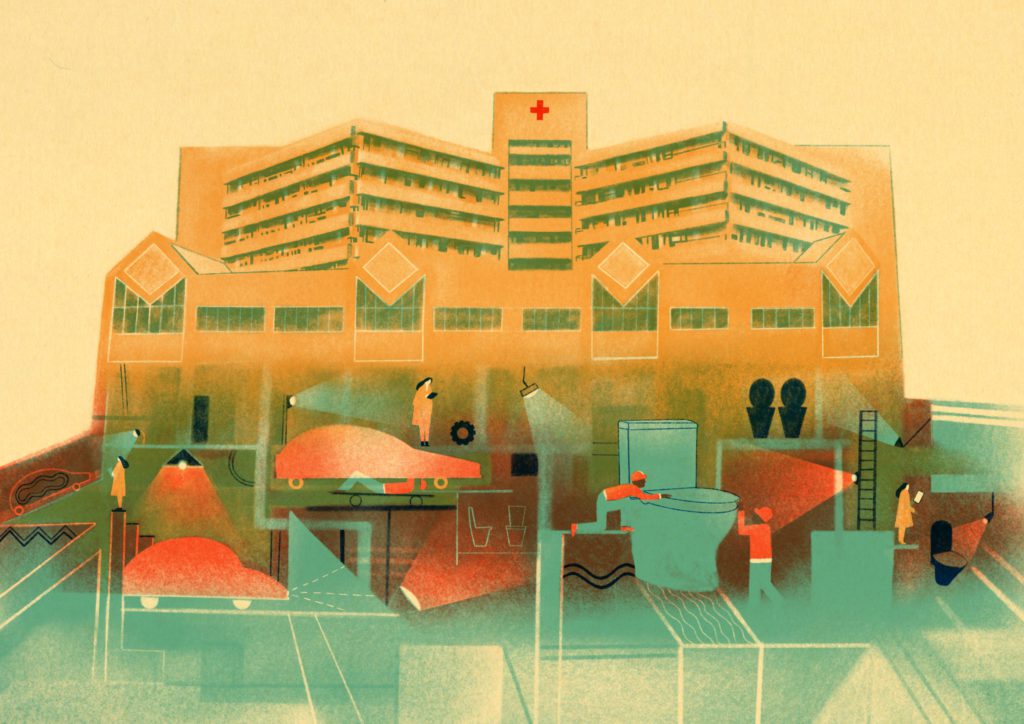
Description
Japanese Red Cross Kumamoto Hospital is functioning as an open innovation lab for humanitarian technologies by collaborating with various stakeholders such as academia, private sector and public institutions.
Context
In hospital management, facilities are often compared to a small society where all the social challenges merge together : ongoing pandemic, super aging-society, the increase of poverty, the rapid population reduction, the aging of infrastructure, energy management, issues of mobility services and climate change.
Since 1980, the Japanese Red Cross Kumamoto Hospital, which is firstly nominated as a hub hospital for the international medical relief activities in the Japanese Red Cross Society, has been deploying its staff to the global disaster response operations. This approach shows that the hospital faces the social challenges and needs the solutions both in peacetime and emergencies.
Technical details & Operations
Kumamoto hospital defines humanitarian technologies as “technologies to protect life and health and ensure respect for human dignity” in other words, technologies for achieving the humanitarian purposes of the Red Cross and Red Crescent movement.
To improve and create humanitarian technologies, the hospital always focuses on “Genba” (the real workplace) in the global (both domestic and overseas) humanitarian field to understand the social challenges and find the essential needs. However, the social challenges in the field are always complicated and cannot be solved only by the efforts of medical professionals in the hospital. Therefore, the international medical relief department at the hospital, which always faces the social challenges in the global humanitarian field, has been playing a key role as an open innovation hub to collaborate with the diverse professionals from academia and private sector.
To create the opportunities toward the collaboration between the hospital and other specialists, the hospital has been seeking for “Serendipity” to meet the diverse specialists with humanitarian mind by participating in humanitarian missions, academic conferences on water, health, civil engineering, e-health and, joining professional associations for different topics such as mobility, drones, automatic voice translation technology, and sharing economy.
In addition, the hospital staff directly visit the specialists in universities and private companies to ask for collaboration and co-creation. In the co-creation process, the hospital staff shares the social challenges found in Genba and co-think the possible solutions with the external experts. For the external partners, this is the precious opportunity to know the essential needs to address the social challenges. If necessary, the hospital and the external experts call another organization or expert for joining the project. The hospital, which is a small society, can be utilised as a test field for the co-created new solutions and products such as the hydrogen ambulance. The hospital staff and the external experts from academia propose and share their new ideas in the academic conference on humanitarian technologies, or by using their public relations resources.
In this way, the hospital has become a multi-disciplinary open innovation hub where the hospital staff and the humanitarian technology specialists from various backgrounds co-create the practical solutions for the social challenges.
Deployment & Impact
The outputs of the open innovation labs are categorised in five types : 1. New Concepts, 2. Prototypes, 3. Service Models, 4. Academic Outputs, and 5. Network of humanitarian technology specialists.
These outputs benefit to solve the social challenges and contribute to improving the hospital services both in peacetime and emergencies. In the 2020 Kumamoto floods response, these outputs offered by the collaborative partners were fully utilised to support the relief activities of the hospital.
- A private company – Agoop corp, Softbank Group – offered the mobile phone locations data to the hospital’s relief team in the disaster affected areas for decision making;
- A mobile flush toilet which is co-created by the hospital and Nishimu – Kyushu Electric Power Group – was installed in the disaster affected area. This innovative flush toilet can be installed without relying on the existing water supply and drainage in the disaster affected areas;
- A Hybrid Vehicle with the power supply function was loaned by Toyota Motor Kyushu as a mobility tool of the hospital’s medical team. A mobile private room which was jointly designed by the hospital, LIXIL and GK Design Group, was installed in a refugee center to accommodate the patient with a fever for infection control under the pandemic.
All the costs of these activities were covered by the participating private companies as their CSR activities. In addition, among the private companies that offered their services for these relief activities, the new business collaboration has started.
Likewise, the hospital creates “Serendipity” which provides the humanitarian technology specialists gathered at the innovation hub with the matchmaking opportunities for creating the new collaboration projects.





